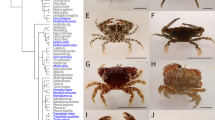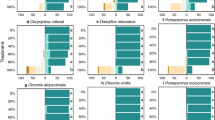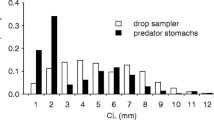Abstract
Outbreaks of crown-of-thorns seastars (CoTS) are one of the leading causes of coral decline on Indo-Pacific coral reefs. Predator removal has been proposed to be a possible mechanism contributing to CoTS outbreaks in this region. Although some data exist on predation of adults, little work has been conducted on predators of juvenile CoTS. The aim of this study was therefore to establish whether predation of juvenile CoTS (1–9 months old after settlement) by peppermint shrimp (L. vittata) is affected by the age, size, or diet of juvenile CoTS. Through a set of ten predation experiments and statistical modeling, this study demonstrated that both age and size of juvenile CoTS are important factors affecting partial and lethal predation. Age was, however, found to be a better predictor of changes in probability (P) of lethal and partial predation (based on smaller AICc). Up to the age of ~ 4 months post-settlement, the probability of lethal predation over a span of 3 d of the experiment was nearly 1. Juvenile CoTS > 4 months old were rarely consumed entirely (P lethal predation = 0) yet showed increased partial predation (such as arm removal or damage to the center of the body) with probabilities increasing after 6 months post-settlement. A subset of CoTS over the age of 4 months was offered either coral or crustose coralline algae (CCA) as food to test for the effect of diet on predation. Diet did not significantly impact either partial or lethal predation. Thus, peppermint shrimp were identified as predators of juvenile CoTS up to an age of 4 months post-settlement, yet partial predation past this age still occurs, which may have consequences on population dynamics. The present study and future research on other juvenile predators fill important gaps in understanding CoTS population outbreaks.


Similar content being viewed by others
References
Ahyong ST (2010) New species and new records of Caridea (Hippolytidae: Pasiphaeidae) from New Zealand. Zootaxa 2372:341–357
Alves DFR, López Greco LS, de Paiva B-A, Hirose GL (2019) Sexual system, reproductive cycle and embryonic development of the red-striped shrimp Lysmata vittata, an invader in the western Atlantic Ocean. PLoS ONE 14:e0210723
Barton K (2009) Mu-MIn: Multi-model inference. R Package Version 0.12.2/r18. http://R-Forge.R-project.org/projects/mumin/
Barton JA, Humphrey C, Bourne DG, Hutson KS (2020) Biological controls to manage Acropora-eating flatworms in coral aquaculture. Aquac Environ Interact 12:61–66
Chace FA (1983) The Caridean Shrimps (Crustacea - Decapoda) of the Albatross Philippine Expedition, 1907–1910. Smithson Contrib to Zool 381:1–152
Clements CS, Hay ME (2017) Size matters: Predator outbreaks threaten foundation species in small Marine Protected Areas. PLoS ONE 12:1–15
Cowan ZL (2017) Predation on the early life stages of the crown-of-thorns starfish (Acanthaster cf. solaris). PhD Thesis, James Cook University.
Cowan ZL, Dworjanyn SA, Caballes CF, Pratchett MS (2016) Predation on crown-of-thorns starfish larvae by damselfishes. Coral Reefs 35:1253–1262
Cowan ZL, Pratchett M, Messmer V, Ling S (2017) Known predators of crown-of-thorns starfish (Acanthaster spp.) and their role in mitigating, if not preventing, population outbreaks. Diversity. https://doi.org/10.3390/d9010007
Cowan ZL, Ling SD, Caballes CF, Dworjanyn SA, Pratchett MS (2020) Crown-of-thorns starfish larvae are vulnerable to predation even in the presence of alternative prey. Coral Reefs 39:293–303
De León JH, Fournier V, Hagler JR, Daane KM (2006) Development of molecular diagnostic markers for sharpshooters Homalodisca coagulata and Homalodisca liturata for use in predator gut content examinations. Entomol Exp Appl 119:109–119
De’Ath G, Fabricius KE, Sweatman H, Puotinen M, (2012) The 27-year decline of coral cover on the Great Barrier Reef and its causes. Proc Natl Acad Sci U S A 109:17995–17999
Deaker DJ, Mos B, Lin H-A, Lawson C, Budden C, Dworjanyn SA, Byrne M (2020a) Diet flexibility and growth of the early herbivorous juvenile crown-of-thorns sea star, implications for its boom-bust population dynamics. PLoS ONE 15:e0236142. https://doi.org/10.1371/journal.pone.0236142
Deaker DJ, Agüera A, Lin HA, Lawson C, Budden C, Dworjanyn SA, Mos B, Byrne M (2020b) The hidden army: Corallivorous crown-of-thorns seastars can spend years as herbivorous juveniles. Biol Lett 16:20190849
Debelius H (2001) Crustacea guide of the world: Atlantic ocean, Indian ocean, Pacific ocean. ConchBooks, Germany
Doyle JR, McKinnon AD, Uthicke S (2017) Quantifying larvae of the coralivorous seastar Acanthaster cf. solaris on the Great Barrier Reef using qPCR. Mar Biol 164:164–176
Endean R (1969) Report on investigations made into aspects of the current Acanthaster planci (Crown-of-thorns) infestations of certain reefs of the Great Barrier Reef. Queensland Department of Primary Industries (Fisheries Branch), Brisbane, Australia
Endean R (1976) Destruction and recovery of coral reef communities. Biol Geol Coral Reefs Vol 3. Biol 2:215–254
Glynn PW, Enochs IC (2011) Invertebrates and their roles in coral reef ecosystems. In: Dubinsky Z, Stambler N (eds) Coral reefs: an ecosystem in transition. Springer, Dordrecht, pp 273–325
Harper GL, Sheppard SK, Harwood JD, Read DS, Glen DM, Bruford MW, Symondson WOC (2006) Evaluation of temperature gradient gel electrophoresis for the analysis of prey DNA within the guts of invertebrate predators. Bull Entomol Res 96:295–304
Keesing JK, Halford AR (1992a) Field measurement of survival rates of juvenile Acanthaster planci: techniques and preliminary results. Mar Ecol Prog Ser 85:107–114
Keesing JK, Halford AR (1992b) Importance of postsettlement processes for the population dynamics of Acanthaster planci (l.). Mar Freshw Res 43:635–651
Keesing JK, Wiedermeyer WL, Okaji K, Halford AR, Hall KC, Cartwright CM (1995) Mortality rates of juvenile starfish Acanthaster planci and Nardoa spp. measured on the Great Barrier Reef, Australia and in Okinawa. Japan Oceanol Acta 19:441–448
Keesing JK, Halford AR, Hall KC (2018) Mortality rates of small juvenile crown-of-thorns starfish Acanthaster planci on the Great Barrier Reef: Implications for population size and larval settlement thresholds for outbreaks. Mar Ecol Prog Ser 597:179–190
Keesing JK, Thomson DP, Haywood MDE, Babcock RC (2019) Two time losers: selective feeding by crown-of-thorns starfish on corals most affected by successive coral-bleaching episodes on western Australian coral reefs. Mar Biol 166:1–11
Kroon FJ, Lefèvre CD, Doyle JR, Patel F, Milton G, Severati A, Kenway M, Johansson CL, Schnebert S, Thomas-Hall P, Bonin MC, Cameron DS, Westcott DA (2020) DNA-based identification of predators of the corallivorous Crown-of-Thorns Starfish (Acanthaster cf. solaris) from fish faeces and gut contents. Sci Rep 10:1–14
Le Vay L, Jones DA, Puello-Cruz AC, Sangha RS, Ngamphongsai C (2001) Digestion in relation to feeding strategies exhibited by crustacean larvae. Comp Biochem Physiol Part A Mol Integr Physiol 128:621–628
Marin IN, Korn OM, Kornienko ES (2012) The caridean shrimp Lysmata vittata (Stimpson, 1860) (Decapoda: Hippolytidae): A new species for the fauna of Russia. Russ J Mar Biol 38:359–363
McCallum HI (1987) Predator regulation of Acanthaster planci. J Theor Biol 127:207–220
McCallum HI (1988) Effects of predation on organisms with pelagic larval stages: models of metapopulations. Proc 8th Int Coral Reef Symp 2:101–106
Mccallum HI (1990) Effects of predation on acanthaster: age-structured metapopulation models. Acanthaster and the Coral Reef: A Theoretical Perspective, Springer- Verlag, Berlin, Heidelberg (Lecture Notes in Biomathematics) 88:208–219
McClintock JB, Baker BJ (1997) Palatability and chemical defense of eggs, embryos and larvae of shallow-water Antarctic marine invertebrates. Mar Ecol Prog Ser 154:121–131
Messmer V, Pratchett M, Chong-Seng K (2017) Variation in incidence and severity of injuries among crown-of-thorns starfish (Acanthaster cf. solaris) on Australia’s Great Barrier Reef. Diversity. https://doi.org/10.3390/d9010012
Murdoch WW, Oaten A (1975) Predation and Population Stability. Adv Ecol Res 9:1–131
Myers RA, Baum JK, Shepherd TD, Powers SP, Peterson C (2007) Cascading Effects of the Loss of Apex Predatory Sharks. Science 315:1846–1850
Ormond RFG, Campbell AC (1974) Formation and breakdown of Acanthaster planci aggregations in the Red Sea. Proc 2nd Int Coral Reef Symp 1:595–619
Ormond R, Bradbury R, Bainbridge S, Fabricius K, Keesing J, de Vantier L, Medlay P, Steven A (1990) Test of a model of regulation of crown-of-thorns starfish by fish predators. Acanthaster and the Coral Reef: A Theoretical Perspective, Springer- Verlag, Berlin, Heidelberg (Lecture Notes in Biomathematics) 88:189–207
Pawlik JR (1993) Marine Invertebrate Chemical Defenses. Chem Rev 93:1911–1922
Pawlik JR (2012) Antipredatory Defensive Roles of Natural Products from Marine Invertebrates. In: Fattorusso E, Gerwick WH, Taglialatela-Scafati O (eds) Handbook of Marine Natural Products. Springer, Netherlands, Dordrecht, pp 677–710
Pawlik JR, Fenical W (1992) Chemical defense of Pterogorgia anceps, a Caribbean gorgonian coral. Mar Ecol Prog Ser 87:183–188
Pawlik JR, Chanas B, Toonen RJ, Fenical W (1995) Defenses of Caribbean sponges against predatory reef fish. I. Chemical deterrency. Mar Ecol Prog Ser 127:183–194
Pearson R (1981) Recovery and Recolonization of Coral Reefs. Mar Ecol Prog Ser 4:105–122
Pratchett M, Caballes C, RiveraPosada J, Sweatman H (2014) Limits to Understanding and Managing Outbreaks of CrownofThorns Starfish (Acanthaster spp.). Oce and Mar Bio 52:133–200
Pratchett MS, Caballes CF, Wilmes JC, Matthews S, Melin C, Sweatman HPA, Nadler LE, Brodie J, Thompson CA, Hoey J, Bos AR, Byrne M, Messmer V, Fortunato SAV, Chen CCM, Buck ACE, Babcock RC, Uthicke S (2017) Thirty Years of Research on Crown-of-Thorns Starfish (1986–2016): Scientific Advances and Emerging Opportunities. Diversity. https://doi.org/10.3390/d9040041
R Core Team (2018) R: a language and environment for statistical computing. R Foundation for Statistical Computing, Vienna, Austria
Rhyne AL, Lin J, Deal KJ (2004) Biological control of aquarium pest anemone Aiptasia pallida Verrill by peppermint shrimp Lysmata risso. J Shellfish Res 23:227–229
Rivera-Posada J, Caballes CF, Pratchett M (2014) Size-related variation in arm damage frequency in the crown-of-thorns sea star, Acanthaster planci. J Coast Life Med 2:187–195
Rumrill S (1990) Natural mortality of marine invertebrate. Ophelia 32:163–198
Stevenson CF, Demes KW, Salomon AK (2016) Accounting for size-specific predation improves our ability to predict the strength of a trophic cascade. Ecol Evol 6:1041–1053
Stimpson W (1858) Prodromus descriptionis animalium evertebratorum, quae in Expeditione ad Oceanum Pacificum Septentrionalem, a Republica Federate missa, Cadwaladaro Ring-gold et Johanne Rodgers Ducibus, observavit et descripsit. Pars V. CrustaceaOcypodoidea Proc Acad Nat Sci Philadelphia 10:93–110
Sweatman HPA (1995) A field study of fish predation on juvenile crown-of-thorns starfish. Coral Reefs 14:47–53
Sweatman HPA (2008) No-take reserves protect coral reefs from predatory starfish. Curr Biol 18:598–599
Uthicke S, Doyle J, Duggan S, Yasuda N, McKinnon AD (2015a) Outbreak of coral-eating Crown-of-Thorns creates continuous cloud of larvae over 320 km of the Great Barrier Reef. Sci Rep 5:16885
Uthicke S, Logan M, Liddy M, Francis D, Hardy N, Lamare M (2015b) Climate change as an unexpected co-factor promoting coral eating seastar (Acanthaster planci) outbreaks. Sci Rep 5:8402
Uthicke S, Liddy M, Patel F, Logan M, Johansson C, Lamare M (2018) Effects of larvae density and food concentration on crown-of-thorns seastar (Acanthaster cf. solaris) development in an automated flow-through system. Sci Rep 8:1–12
Vaughan DB, Grutter AS, Hutson KS (2018) Cleaner shrimp are a sustainable option to treat parasitic disease in farmed fish. Sci Rep 8:1–10
Warner RR, Hughes TP (1988) The Population Dynamics of Reef Fishes. Proc 6th Int Coral Reef Symp 1:149–155
Wilmes JC, Caballes CF, Cowan ZL, Hoey AS, Lang BJ, Messmer V, Pratchett MS (2018) Contributions of pre-versus post-settlement processes to fluctuating abundance of crown-of-thorns starfishes (Acanthaster spp.). Mar Pollut Bull 135:332–345
Wilmes JC, Hoey AS, Messmer V, Pratchett MS (2019) Incidence and severity of injuries among juvenile crown-of-thorns starfish on Australia’s Great Barrier Reef. Coral Reefs 38:1187–1195
Wilmes JC, Hoey AS, Pratchett MS (2020a) Contrasting size and fate of crown-of-thorns starfish linked to ontogenetic diet shifts. Proc R Soc B 287:20201052. https://doi.org/10.1098/rspb.2020.1052
Wilmes JC, Schultz DJ, Hoey AS, Messmer V, Pratchett MS (2020b) Habitat associations of settlement-stage crown-of-thorns starfish on Australia’s Great Barrier Reef. Coral Reefs 39:1163–1174
Yamaguchi M (1974) Growth of Juvenile Acanthaster planci (L.) in the Laboratory. Pacific Sci 28:123–138
Acknowledgements
This project was funded by the AIMS@JCU Pilot Study scholarship and research allocations supplied by Australian Institute of Marine Science and the College of Science and Engineering, James Cook University. We are grateful to Charlotte Johansson, Frances Patel and the team at the National Sea Simulator at AIMS for their help with running of experiments and logistics.
Author information
Authors and Affiliations
Corresponding author
Ethics declarations
Conflict of interest
On behalf of all authors, the corresponding author declares that there is no conflict of interest.
Additional information
Publisher's Note
Springer Nature remains neutral with regard to jurisdictional claims in published maps and institutional affiliations.
Topic Editor Morgan S. Pratchett
Rights and permissions
About this article
Cite this article
Balu, V., Messmer, V., Logan, M. et al. Is predation of juvenile crown-of-thorns seastars (Acanthaster cf. solaris) by peppermint shrimp (Lysmata vittata) dependent on age, size, or diet?. Coral Reefs 40, 641–649 (2021). https://doi.org/10.1007/s00338-020-02047-w
Received:
Accepted:
Published:
Issue Date:
DOI: https://doi.org/10.1007/s00338-020-02047-w




